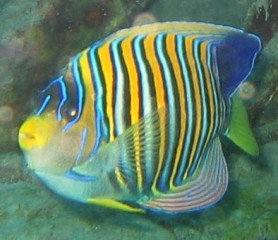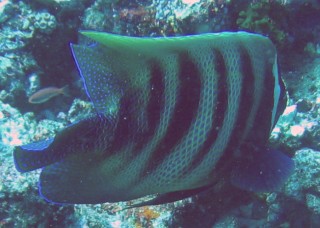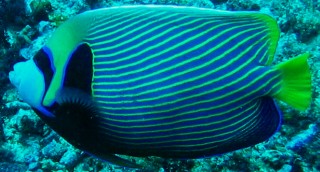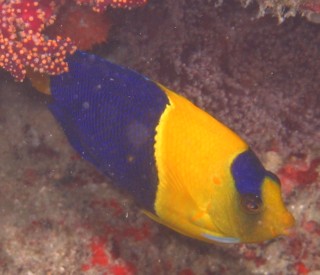Angelfish
Angelfishes, family Pomacanthidae, might be said to be the "classic"
tropical reef fish. Bright, colorful, pleasingly oval shaped and ubiquitous these fish
(and the closely related Butterflyfish) are probably the first to catch the eye
of a snorkeler in tropical waters.
How do you tell an angelfish from a butterflyfish? Although Angelfish and
Butterflyfish (family Chaetodontidae)
are closely related -- in fact they were once classified in the same family --
they do have marked differences. Both families have species that are laterally
compressed (i.e. they look skinny when seen from the top or head or tail), and
generally oval shaped. Angelfishes are larger, somewhat more secretive then
their smaller butterfly cousins. They are mainly herbivores and feed on algae and sponges. Adults of both
families tend to live alone or in pairs. Angelfish can be told from the butterflyfish by their more robust bodies and
(if you can get close enough for a good look) the presence of a sharp spine below their gill covers.
Butterflyfish are mainly white, yellow and black, whereas many of the angelfish
have a lot of blue. The best way to tell them apart is to study the guides and get to know them, so
as you snorkel or dive you can mentally recite their names!
The location in parentheses tells where the shot was taken. Most information was taken from
Reef Fish Identification: Tropical Pacific by Allen, Steene, Humann, and Deloach and Reef Fish of the Maldives by Dr. Charles
Anderson (now out of print). For more on the books we use, click
here. Photos copyrighted
Hackingfamily.com, with credits mostly to Christopher Hacking.
by Allen, Steene, Humann, and Deloach and Reef Fish of the Maldives by Dr. Charles
Anderson (now out of print). For more on the books we use, click
here. Photos copyrighted
Hackingfamily.com, with credits mostly to Christopher Hacking.

The Lemonpeel Angelfish Centropyge flavissimus makes a bright splash of yellow on the
French Polynesian reefs. The blue edge on the gill-cover distinguishes
it from the Mimic Surgeonfish. These fish are often in harems in and
around coral heads. (Moorea, Fr. Polynesia) |

One of the most dramatic reef fishes is the Regal Angelfish
Pygoplites diacanthus. It
attains lengths of up to 10 inches, and feeds on sponges and
tunicates. Its range extends from the Red Sea and E. Africa to
Polynesia. (Fr. Polynesia) |
| The Vermiculated Angelfish Chaetondontoplus mesoleucus
was a new one for us when we saw it on the reefs off Pink Beach, Komodo
Island. Like most other angelfish it has unmistakable patterns to its
colors: yellow face and tail, a black racoon band over the eyes, and
white fading to black body. Its range extends from Indonesia to the
Philippines and from S.W. Japan to N. Australia (Indonesia) |
 |
 |
I'm sorry we don't have a good face shot of this guy, but the dark
bars clearly show this to be the Six-Banded Angelfish
Pomacanthus sexstriatus. The white bar on the face (just visible) is
right behind the eye, and the rest of the face is dark blue. Dorsal,
anal and tail fins are blue-spotted, though the dorsal is more tan or
yellow. They're solitary or in pairs on coastal, lagoon, and outer
reefs. (Komodo NP, Indonesia) Photo by Amanda Hacking. |
Slow and stately, the Emperor Angelfish Pomacanthus
imperator wins its common name as it moves leisurely amongst the
coral heads and overhanging plate corals in search of food. This
beautiful fish with the blue face, yellow tail fins and distinctive
yellow and blue stripes is found from the Red Sea to French Polynesia.
It makes a loud drumming sound when alarmed, something we have never heard.
Perhaps we're doing something right when we move in quietly for a photo!
(Komodo NP, Indonesia) Photo by Amanda Hacking |
 |

We saw the Keyhole Angelfish Centropyge tibicen on the reef
at Dumbea Pass in New Caledonia. This lovely fish is actually dark blue,
but light plays funny tricks. At least the yellow anal fin is clear, as is
the white "keyhole" mark. (Sue Hacking) |

Dramatically obvious on the reefs of Tonga, Fiji, New Caledonia and
Indonesia is the lovely Bicolor Angelfish Centropyge bicolor.
With its bright yellow head and tail, deep blue body and blue forehead
blotch it is unmistakable. It grows to about 15 cm (6 inches) and may be
solitary, in pairs or small groups. (Fiji) Photo by Chris Hacking |
Up | Nudibranchs | Coral Reef | Venomous Animals | Angelfish | Butterflyfish | Damselfish | Puffers | Sharks & Rays | Snappers & Breams | Surgeon/Rabbit Fish | Triggerfish | Wrasse & Parrotfish | Other Reef Fish
Reef Animals | UW Photo How-to | Scuba Diving
Top Level:
Home |
Destinations |
Cruising Info |
Underwater |
Boat Guests |
Ocelot |
Sue |
Jon |
Amanda |
Chris |
Site Map |
Make a Comment
 |
Lifetime
Commodores
of the
Seven Seas
Cruising
Association |
 |
|
If our information is useful,
you can help by making a donation
|
Copyright © 2000‑ Contact:
Jon and Sue Hacking -- HackingFamily.com, svOcelot.com.
All rights reserved.
by Allen, Steene, Humann, and Deloach and Reef Fish of the Maldives by Dr. Charles
Anderson (now out of print). For more on the books we use, click
here. Photos copyrighted
Hackingfamily.com, with credits mostly to Christopher Hacking.